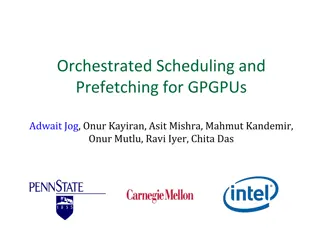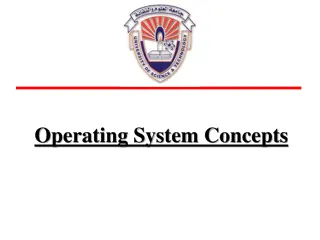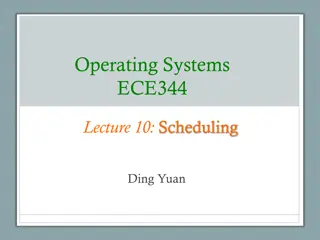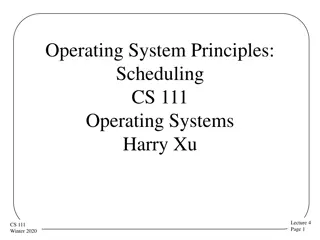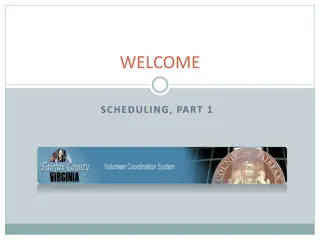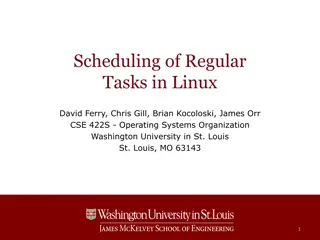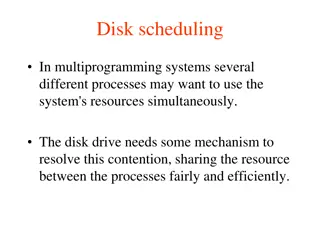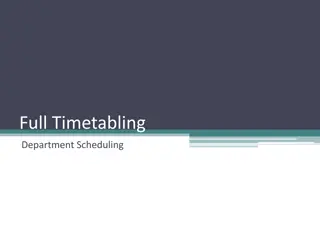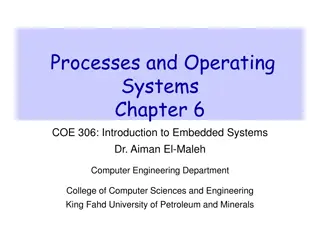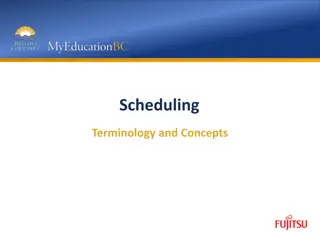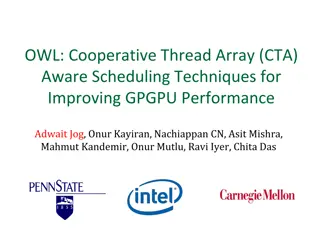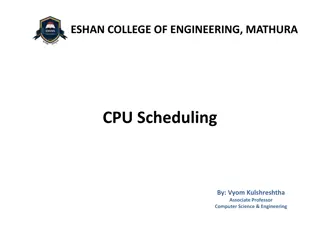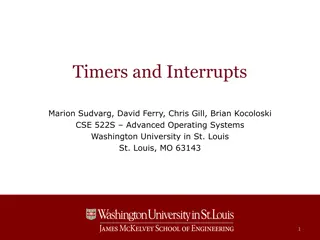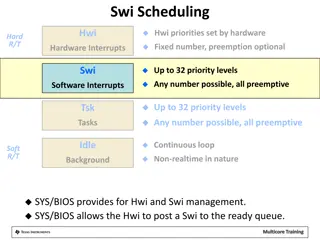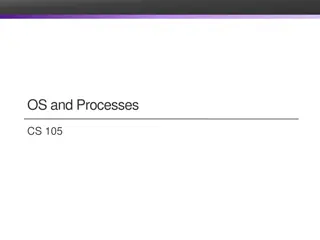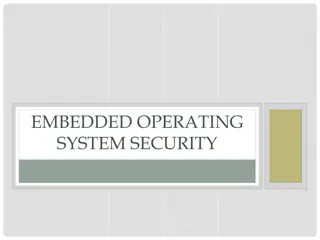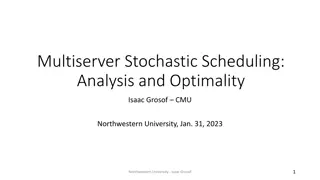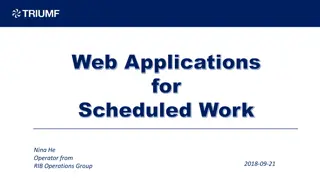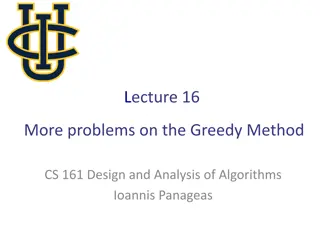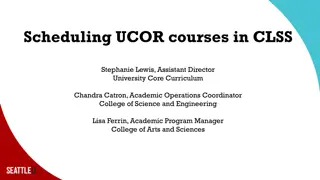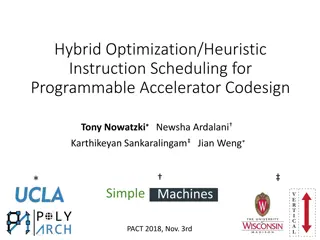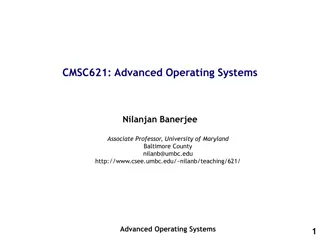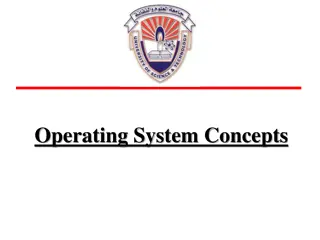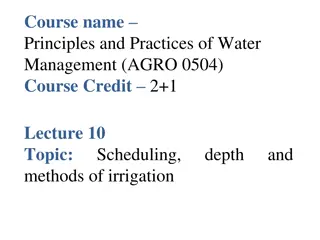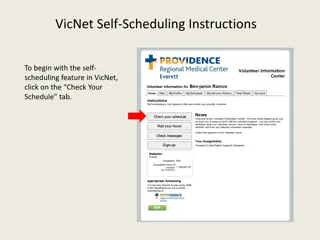Scheduling Strategies in Operating Systems
Operating systems utilize various scheduling algorithms to manage the execution of tasks efficiently. This includes strategies like First In, First Out (FIFO), Shortest Job First (SJF), and Shortest Time-to-Completion First (STCF). Each algorithm has its advantages and limitations, impacting factors such as turnaround time and fairness. By understanding these scheduling metrics and methods, system designers can optimize performance and resource utilization.
Download Presentation

Please find below an Image/Link to download the presentation.
The content on the website is provided AS IS for your information and personal use only. It may not be sold, licensed, or shared on other websites without obtaining consent from the author. Download presentation by click this link. If you encounter any issues during the download, it is possible that the publisher has removed the file from their server.
E N D
Presentation Transcript
7. Scheduling: Introduction Operating System: Three Easy Pieces 1 Youjip Won
Scheduling: Introduction Workload assumptions: 1. Each job runs for the same amount of time. 2. All jobs arrive at the same time. 3. All jobs only use the CPU (i.e., they perform no I/O). 4. The run-time of each job is known. 2 Youjip Won
Scheduling Metrics Performance metric: Turnaround time The time at which the job completes minus the time at which the job arrived in the system. ???????????= ??????????? ???????? Another metric is fairness. Performance and fairness are often at odds in scheduling. 3 Youjip Won
First In, First Out (FIFO) First Come, First Served (FCFS) Very simple and easy to implement Example: A arrived just before B which arrived just before C. Each job runs for 10 seconds. A B C 20 40 60 80 100 120 0 Time (Second) ??????? ?????????? ???? =?? + ?? + ?? = ?? ??? ? 4 Youjip Won
Why FIFO is not that great? Convoy effect Let s relax assumption 1: Each job no longer runs for the same amount of time. Example: A arrived just before B which arrived just before C. A runs for 100 seconds, B and C run for 10 each. A B C 20 40 60 80 100 120 0 Time (Second) ??????? ?????????? ???? =??? + ??? + ??? = ??? ??? ? 5 Youjip Won
Shortest Job First (SJF) Run the shortest job first, then the next shortest, and so on Non-preemptive scheduler Example: A arrived just before B which arrived just before C. A runs for 100 seconds, B and C run for 10 each. B A C 20 40 60 80 100 120 0 Time (Second) ??????? ?????????? ???? =?? + ?? + ??? = ?? ??? ? 6 Youjip Won
SJF with Late Arrivals from B and C Let s relax assumption 2: Jobs can arrive at any time. Example: A arrives at t=0 and needs to run for 100 seconds. B and C arrive at t=10 and each need to run for 10 seconds [B,C arrive] A B C 20 40 60 80 100 120 0 Time (Second) ??????? ?????????? ???? =??? + ??? ?? + (??? ??) = ???.?? ??? ? 7 Youjip Won
Shortest Time-to-Completion First (STCF) Add preemption to SJF Also knows as Preemptive Shortest Job First (PSJF) A new job enters the system: Determine of the remaining jobs and new job Schedule the job which has the lest time left 8 Youjip Won
Shortest Time-to-Completion First (STCF) Example: A arrives at t=0 and needs to run for 100 seconds. B and C arrive at t=10 and each need to run for 10 seconds [B,C arrive] A B A C 20 40 60 80 100 120 0 Time (Second) ??????? ?????????? ???? =(??? ?) + ?? ?? + (?? ??) = ?? ??? ? 9 Youjip Won
New scheduling metric: Response time The time from when the job arrives to the first time it is scheduled. ?????????= ????????? ???????? STCF and related disciplines are not particularly good for response time. How can we build a scheduler that is sensitive to response time? 10 Youjip Won
Round Robin (RR) Scheduling Time slicing Scheduling Run a job for a time slice and then switch to the next job in the run queue until the jobs are finished. Time slice is sometimes called a scheduling quantum. It repeatedly does so until the jobs are finished. The length of a time slice must be a multiple of the timer-interrupt period. RR is fair, but performs poorly on metrics such as turnaround time 11 Youjip Won
RR Scheduling Example A, B and C arrive at the same time. They each wish to run for 5 seconds. A B C ???????? ????????=0 + 5 + 10 = 5??? 3 5 10 15 20 25 30 0 Time (Second) SJF (Bad for Response Time) A B C A B CA B CA B CA B C ???????? ????????=0 + 1 + 2 = 1??? 3 5 10 15 20 25 30 0 Time (Second) RR with a time-slice of 1sec (Good for Response Time) 12 Youjip Won
The length of the time slice is critical. The shorter time slice Better response time The cost of context switching will dominate overall performance. The longer time slice Amortize the cost of switching Worse response time Deciding on the length of the time slice presents a trade-off to a system designer 13 Youjip Won
Incorporating I/O Let s relax assumption 3: All programs perform I/O Example: A and B need 50ms of CPU time each. A runs for 10ms and then issues an I/O request I/Os each take 10ms B simply uses the CPU for 50ms and performs no I/O The scheduler runs A first, then B after 14 Youjip Won
Incorporating I/O (Cont.) A A A A B B B B B A 140 20 40 60 Time (msec) 80 100 120 0 Poor Use of Resources A A B B A B B A B A Maximize the CPU utilization 140 20 40 60 Time (msec) 80 100 120 0 Overlap Allows Better Use of Resources 15 Youjip Won
Incorporating I/O (Cont.) When a job initiates an I/O request. The job is blocked waiting for I/O completion. The scheduler should schedule another job on the CPU. When the I/O completes An interrupt is raised. The OS moves the process from blocked back to the ready state. 16 Youjip Won
Disclaimer: This lecture slide set was initially developed for Operating System course in Computer Science Dept. at Hanyang University. This lecture slide set is for OSTEP book written by Remzi and Andrea at University of Wisconsin. 17 Youjip Won


